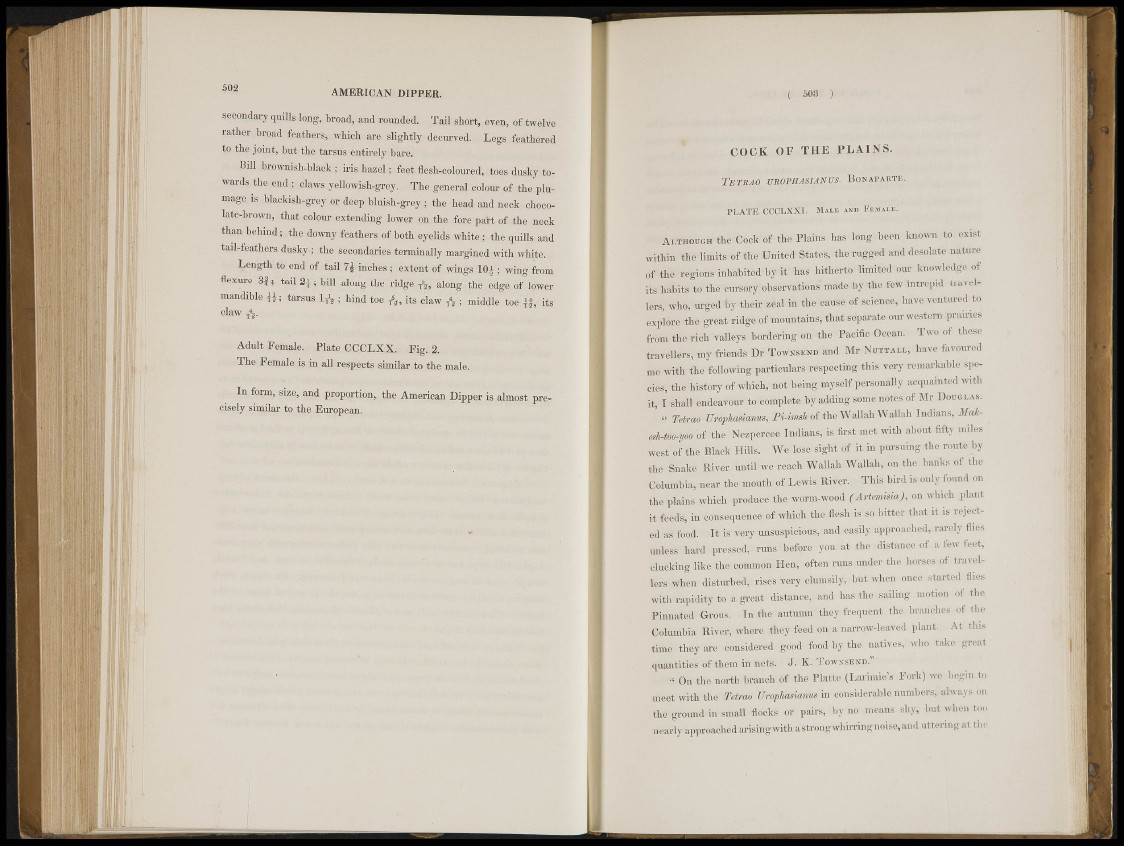
502
AMERICAN DIPPER.
secondary quills long, broad, and rounded. Tail short, „von, of twelve
r a l l ": '' ,m" l d feathers,. wlMk are Mijvhtly.ioeurml. Legg feathered
to the joint, but the tarsus entirely bare.
Bill brownish-black : » tazel 5 feet Hoslwolonred, too,-! dusky towards
the ffidiijfiiWs yellowish-grey. The general colour of the plumage
blackish-grey or deep bluish-groy , the head andjieok choqolite
brown, .that colour extending lower on the fore part of the neck
than. behind; the downy feathers of both eyelids, white fuills and
tail-feathers dusky^jthe secondaries terminally margined with white.
• length to (.rid of tail 7 | inches ; extent of wings 10.}: wing from
flexhre 3| ;, tail 2.! ; bill -along the ridge A, along-thl, edge of lower
m a n d i b l e M m l ^ j hind toe its claw A s middle toe its
claw r
4j. .
Adult Female. Plate CCCLXX. Fig. 2.. s ,
The Female is in-all respects similar to the male.
In form, ske, and proportion, the American Dipper is almost precisely
similar to the European.
if. ¡SMffi ?
COCK OF THE PLAINS.
TETRAO- UllOPllA.ilAXUS. BONAPARTE.
PLATE OCOLXXI. SlitE ANB FI:MAI.K.'
A i.Tiierwi the 'Cock of the Plains has long teen known to exist
within the limits of ffie UniteS States, fire Tugged and desolate nature
of the regions »habited' hy it has hitherto 'limited our knowledge of
its M i t s to the cursory observations made by the few intrepid travellers,
who, urged by their zeal in Ae 'cause of science; hate ventured to
explore the great ridge of mountains, that separate our western prairies
froFi the rich valleys bordering on the Pacific Ocean. Two of these
travellers, my friends Dr TOWSSM™ and Mr NOTI-ALL, have favoured
me with the following particulars respecting this very remarkable'species,
the history of which, not being myself personally acquainted with
I shall endeavour to -complete by adding some notes of Mr DOUGI,AS.
!,' T?eU-ao Urdphasia/'¿«awi-of .the Wallah Wallah Indians, Makesk
too foo of the Nezpercee Indians, is first met with about fifty miles
west of the Black Hills. We lose sight of it in pursuing the route by
the Snake River until we reach Wallah Wallah,- on the. banks of the
Columbia, near the mouth of Lewis River. This.bird-is only found on
the plains which produce, the worm-wood (ArtanisiaJ, on which plant
it foods, in c-on*iiquotice;of which the flesh is so bitter that it is rejected
'aii food. It is very unsuspicious, and easily approached, rarely flies
»less tad pressed, runs before JOB at the distance of a few feet,
chicking like the common Hen-, often rims under the horses of travellers
when disturbed',• rises very clumsily, but.when once started flies
With rapidity to a great distance, and has-the sailing motion of the
Pinnated Grous. In .the autumn they frequent the branches of the
. Columbia River, where they feed on a narrow-leaved plant. At this
time they are considered good food by the natives, who take great'
qua.Tiri.tte6 of them in nets. '- .1. K. TOWXSEXD."
« On the north branch of the Platte (Larimie's Fork) we begin to
meet with the Tamo Urophasimms in considerable numbers, -always on
the ground in small flocks or pairs, by no means shy, but when too
hesfrly approached arising with astrongwhirringnoise, and uttering at the